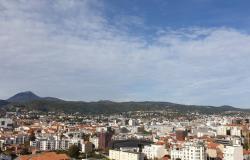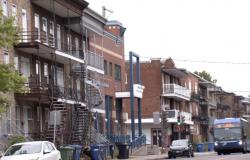Montreal wants to accelerate the densification of its territory in order to deliver 200,000 more housing units by 2050. But to avoid making road congestion even greater, the City hopes to combine this real estate development with that of public transportation.
Posted at 1:13 a.m.
Updated at 5:00 a.m.
“We want to unlock Montreal’s development potential. And that will involve intelligent densification objectives,” says Mayor Valérie Plante, in an interview in the offices of The Press.
In its Urban Planning and Mobility Plan (PUM) 2050, which will be unveiled this Tuesday, its administration will make way for a new measure of densification, based on housing per hectare, with scales for a low densification zone , moderate or high.
PHOTO MARCO CAMPANOZZI, THE PRESS
Valérie Plante, Robert Beaudry and Sophie Mauzerolle (from left to right) in the offices of The Press
A sector classified as first category can develop between 15 and 60 units per hectare, while a district considered “moderate” can have between 60 and 200 housing units per hectare. Finally, at the highest levels of densification, we will be able to exceed more than 200 housing units per hectare.
In the city center, for example, the densification zone will be “high”, but in more remote or heritage areas, it could be low or moderate. “Single-family homes where we would allow, for example, the addition of a floor, a backyard, extensions, in areas like Pointe-aux-Trembles or Saint-Laurent, that would be low,” says the head of the urban planning, Robert Beaudry, who accompanied the mayor during the editorial meeting with The Press.
The objective: to develop 200,000 more housing units, of which 20% would be “off-market”. In other words, they would most often be developed by cooperatives or organizations and would not follow market fluctuations.
In the shorter term, the City aims to reach an overall threshold of 12% “non-market” housing within 10 years. Right now, that rate is just 7%.
In March, the Montreal Metropolitan Community had already proposed requiring a density of 450 housing units per hectare in the city center, while the threshold was 150 housing units per hectare until now. Elsewhere in Greater Montreal, for suburban neighborhoods with a Réseau express métropolitain station, it was suggested that the threshold increase from 80 to 200 units per hectare.
The majority of large cities which have reviewed their urban planning have also integrated this approach. Instead of prescribing heights and densities, this allows an approach based on each reality. We are coming to change the paradigm.
Robert Beaudry, responsible for urban planning at the City of Montreal
As for the authorized heights, this “will depend on each sector, each typology”, specifies the elected official.
“A high density can be seven floors, but very established, or 30 floors, but very tapered. The idea, for us, is to have the land footprint to, among other things, create green spaces,” persists Mr. Beaudry, who recalls that these orientations “will then translate into more regulations in the districts. accurate “.
A “gift” for Guilbault
Along public transport networks, such as the future extension of the blue line, “densification will necessarily be high”, adds Mayor Valérie Plante.
“We are changing the formula, because we no longer want to make the mistake of the past, that is to say, building an entire neighborhood only to realize that, oops, we should have used public transportation. The two go together, and that’s what we want,” she notes.
Moreover, she maintains that her PUM is “a gift” to the Minister of Transport, Geneviève Guilbault, who is preparing the arrival of her transport agency.

PHOTO MARCO CAMPANOZZI, THE PRESS
The mayor of Montreal, Valérie Plante, in an editorial interview at The Press
We did all the analyses, collected all the data. It is a vision that will allow higher governments to put public transportation directly where it is needed. […] And we give it to them on a silver platter.
Valérie Plante, mayor of Montreal
She thus says that she wanted to be “strategic”, in a context where “the City has a limit in financing public transport” and where the government does not seem to want to finance transporters more. “If a government decides that, for it, this is not a priority or that it does not have a long-term vision, at least it will have to respond to well-documented planning,” says the mayor.
For the rest, she promises that the pedestrian will be “at the center of the process” of the Urban Plan, which must, before its adoption, go through the Montreal Public Consultation Office. “When we talk about a city on a human scale, that’s it. Of course, we want height, but we have to think so that it is done coherently and so that the citizen does not feel overwhelmed. »
The mayor believes that there is “still a lot of education to be done” in terms of sharing the road. “In Montreal, we have 10,000 km of streets, but barely 1% with cycle paths, so we are far from the city all by bike. Everyone has their place, and we don’t think cars are going to disappear. […]but we must not add the same number of cars as there are more citizens,” she concludes.
Keeping young families in Montreal
The Plante administration wants to convince young families to stay in Montreal by promoting the construction of more housing with three bedrooms or more.
“What makes them leave the metropolis is often the second child,” explains Robert Beaudry, responsible for urban planning at the City of Montreal.
More Montrealers leave the island for the suburbs than suburbanites settle in the city, particularly young families. In 2022-2023, the island of Montreal lost 25,600 more people than it welcomed to the benefit of other regions of Quebec, according to the Institute of Statistics of Quebec.
The 2050 Urban Planning and Mobility Plan provides for a denser city, but one that would still be attractive to families, according to Mr. Beaudry. In particular by building large “off-market” housing to allow “families at all income levels to be able to stay in Montreal”.
The goal is to plan better while taking their needs into account. “We can no longer think of a neighborhood without schools,” he illustrates.
The municipal administration will also redouble its efforts to green “currently very gray places to attract families,” he continues.
Mayor Valérie Plante cites the future Faubourgs district, which brings together the former Radio-Canada house and the Molson factory, as an example of this new vision of a “complete district”. This approach integrates “land for a school, green spaces and access to water which will become public,” she explains.
Thomas Dussault, The Press








